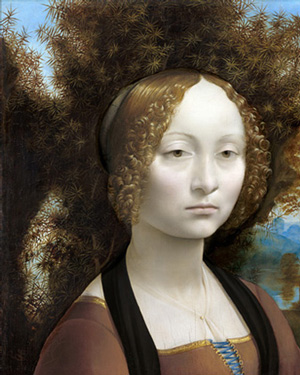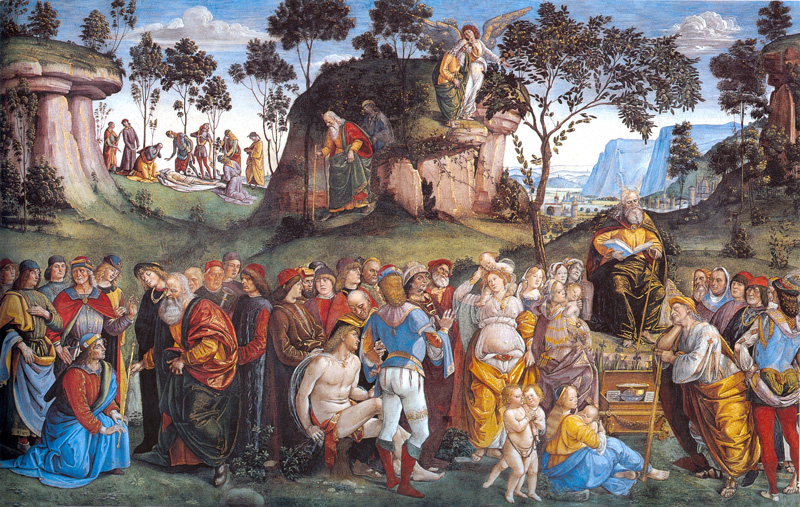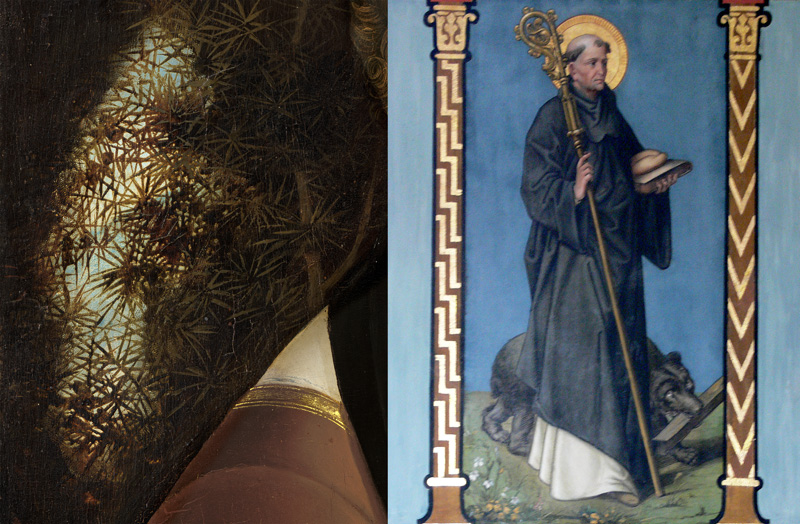continued from previous posts: • Leonardo, painter and prophet • In the beginning was the Word • She gave birth to a son
So whatever happened to Fioretta Gorini after she gave birth to her child Giulio, said to have been the illegitimate son of Giuliano de’ Medici? For the first seven years of his life Giulio was raised by Antonio da Sangallo (the Elder) and then brought up in the Medici household. His uncle Lorenzo de Medici became Giulio’s guardian.

It wasn’t until 1513 that Fioretta’s name surfaced again when the newly elected Pope Leo X wanted to make his cousin Giulio a cardinal. Problem for the Church was that Giulio’s illegitimacy stood in the way. This was rectified when apparently Fioretta’s brother, supported by some monks, testified that his sister and Giuliano de’ Medici had married secretly. Giulio’s birth was legitimised and he was made Cardinal on September 23, 1513 when he was 35 years old. Ten years later he became Pope Clement Vll. His birth is given as May 26, 1478, exactly a month after Giuliano de’ Medici’s assassination on April 26. If Giulio was aware that Giuliano and Fioretta had married, then why did it take a man in his influential position, or the Medici family, so long to pursue his legitimacy? Or was this claim of marriage simply one of convenience to clear the path for Giulio to join the ranks of the cardinalate?
That it was Fioretta’s brother who was said to have confirmed the marriage, and not his sister, would suggest she was no longer alive at the time. Neither has any record come to light as to when Fioretta died, but presumably it was prior to 1513.

If Fioretta had been married to Giuliano then why would she not declare her marriage and her son to the Medici family? Why was it left to Antonio da Sangallo, the child’s godfather, to inform Lorenzo de’ Medici of the birth and then to take the boy into his own house for the first seven years of his life? And was there a reason why Fioretta’s own family did not not take charge of or support her child?
Leonardo da Vinci and Sandro Botticelli provide clues in their paintings about Fioretta’s circumstances following Giuliano’s murder and the birth of her son. They both suggest that Fioretta entered cloistered life, which may explain why she was not on hand to raise her child. Leonardo points to the Carmelite Order, while Botticelli implies she may even have become an anchorite, walled into her cell. Was her exile from the world self-imposed, perhaps the result of a religious conversion of epiphany experience, or was pressure applied on Fioretta to ‘disappear’ in this way?

There are two other paintings that point to Fioretta’s circumstances before and after Giuliano’s death. Of its time, around 1481, is a fresco in the Sistine Chapel titled Testament and Death of Moses, attributed to Luca Signorelli and Bartolomeo della Gatta. The other painting is titled Parnassus and was produced by Andrea Mantegna twenty years after the assassination of Giuliano de Medici. It is now housed in the Louvre, Paris. Mantegna’s painting combines the references to Fioretta in Leonardo’s portrait known as Ginevra de’ Benci (NGA, Washington) and also those in Botticelli’s Madonna with Child and the Infant Saint John the Baptist (Barber Institute, Birmingham). The reference to Fioretta in the Sistine Chapel fresco points to her ‘new life’ or ‘transfiguration’.

Leonardo’s Carmelite reference is the bearded head of the prophet Elijah placed among the juniper and above Fioretta’s right shoulder. Carmelites follow an ideal of life as witnessed and experienced by Elijah. Already mentioned in a previous post is the juniper was the tree that Elijah sat under in the wilderness, when he wished he was dead and asked God to take his life (1 Kings 19:4).

The water feature at Fioretta’s left shoulder represents ‘Elisha’s Spring’. Elisha was the ‘adopted’ son of Elijah. At the time the prophet was taken up into heaven, Elisha requested and received a double share of Elijah’s spirit. Soon afterward Elisha performed his first miracle by purifying Jericho’s water supply which was considered the cause of many miscarriages. The ‘adopted son of Elijah’ can be understood as Fioretta’s son Giulio being first ‘adopted’ by his godfather Antonio da Sangallo (the Elder), a notable Florentine woodworker (and later an architect), and so another identity Leonardo has applied to the ‘head’ in the trees – placed at the shoulder in support of Fioretta, as he would have been when the child was baptised. It was near to Jericho that John the Baptist is said to have baptised Jesus in the river Jordan. Notice also the young, golden tree that rises from the waterside and merges with the juniper – symbolic of a tree of life and the safe delivery of Fioretta’s son Giulio.
Further confirmation that the shape above the Fioretta’s right shoulder is a pointer to Antonio da Sangallo is the the name Sangallo, Italian for Saint Gaul. One of the saint’s artistic attributes is a bear bringing him piece of wood, as seen below in the right hand image. The image on the left represents an ‘upright’ bear carrying a forked branch. Leonardo points to this using a triangular ‘pyramid’ – symbolic of Giuliano’s recent death. The branch is shaped as the letter Y or the Greek upsilon. Its symbolism did not go unnoticed by Pythagorus and the Roman writer Persius commented: “…the letter which spreads out into Pythagorean branches has pointed out to you the steep path which rises on the right.” Isidore of Seville later wrote: “Pythagorus of Samos formed the letter Y as an example of human life; its lower branch signifies the first stage, obviously because one is still uncertain and at this stage submits oneself either to the vices or the virtues. The fork in the road begins with adolescence. Its right path is arduous, but conducts to the blessed life; the left one is easier but leads to pernicious death.” Leonardo has depicted Fioretta as taking the narrow, arduous path.

Right: A mural in a German church of Saint Gaul with a bear carrying wood.
The scapular, though black and not brown, is symbolic of the one presented by the Virgin Mary in the 13th century to Simon Stock, prior general of the Carmelite Order, with the promise of salvation for those who wear it. The scapular formed part of the brown habit worn by Carmelites and also became a symbol of consecration to Our Lady of Carmel. That Fioretta’s scapular is black and not brown is because she is in mourning for Giuliano de’ Medici.
There is one more reference in Leonardo’s painting that links to Elijah and the ‘new life’ of Fioretta after Giuliano de’ Medici was slaughtered and stabbed 19 times by assassins during Mass in the Duomo of Florence, Santa Maria Fiore. It relates to the time Elijah challenged the prophets of Baal to call on their god to light a fire for their animal sacrifice (1 Kings 18:20-40). Despite their prayers, their chants and dancing around the altar, the wood on which the bull was laid did not catch fire. Even when the priests gashed themselves with swords and knives, as was their custom, and the blood flowed down them, their god remained silent and the fire unlit. The bloodletting and slaughter is the reference Leonardo has used to link his painting to the slaughter and stabbings in the Duomo.

said to be modelled on Ginevra Gorini.
Then Elijah prepared another altar and “took twelve stones, corresponding to the number of tribes of the sons of Jacob, to whom the word of Yaweh had come.” The reference to stone and the word of the Lord is Leonardo’s pointer to the stone appearance of Fioretta and Verrocchio’s marble sculpture which he may have used to base his portrait on, while “to whom the word of Yaweh had come” is applied to Fioretta’s religious conversion and decision to join the Carmelite Order.
Elijah doused his sacrifice in water (mixed with the blood of the bull) and then called on God to win back the hearts of the people. “Then the fire of Yaweh fell and consumed the holocaust and wood and licked up the water in the trench. When the people saw this they fell on their faces. ‘Yaweh is God’ they cried ‘Yaweh is God’.” (1 Kings 18:38-39). It was at this moment during the Mass in the Duomo, following the Eucharistic prayer offered by the priest, and when the consecrated Host was raised and heads bowed, that was the signal for the attack on the Medici brothers.
• My next post deals with the reference to Fioretta as she appears in one of the Sistine Chapel’s frescoes… More on Fioretta Gorini

You must be logged in to post a comment.